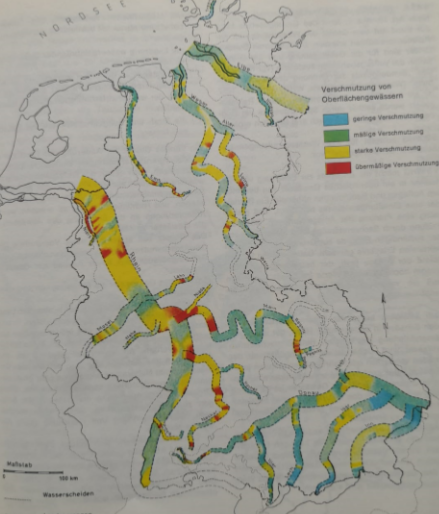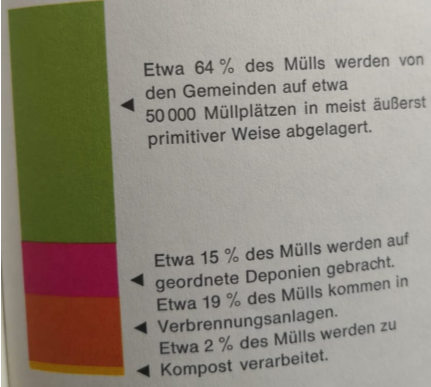A Sustainable Future: Lessons from the Past
by Shadi Rachid
We are witnessing a growing realisation that climate change is a present reality, and not just a future scenario. With that, the need to act and perform the necessary changes on all levels ranging from personal lifestyle to the entire productive and economic sectors, is no longer debatable. So how exactly is that accomplished? Perhaps we can find the answers we are looking for in a not so distant past.
To take this trip to the past, I sat with my lecturer Roland Schnell and had a very enlightening discussion. Mr. Schnell had started studying chemistry back in 1972 at the TU Karlsruhe (now knows as KIT). Here his involvement and insight on environmental matters began.
Why was the situation in Germany so bad?
First of all, we must clearly state that this is not the first environmental crises requiring action in the human history. Today, many environmental friendly practices, regulations and technologies are just taken for granted. However, Mr. Schnell went on to characterise the situation in Germany in the 70s and 80s. When it comes to solid wastes, no practical treatment existed. Every village had an open dumpsite where they would dump all their garbage and most probably set it on fire during the night. This had created horrible air quality in residential areas. Furthermore, no regulations existed to control water quality as well. Therefore, sewages went untreated flowing into the rivers along with chemical wastes from industries. For instance, parents would forbid their children of swimming in the famous Rhein river. So how did Germany go from such a situation to a country providing potable tap water?

What role can the public even Play?
The German public played the main role to push to the adapting of environmental friendly technologies and practices in many different fields. Driven by deteriorating air quality, water pollution and health concerns, people started to get together discussing the unacceptable situation and the prospects of change. What started of as small local groups spread across west Germany, soon turned into a bigger alliance. (Nowadays we see them with NABU and BUND) Awareness on those issues was exponentially rising. Additionally, newspapers and other media were increasingly highlighting the environmental problems and concerns. Furthermore, actions were not limited to demonstrations and protests. Involved citizens and environmental groups took their discussions into town-hall meetings, conventions and local government elections.
Soon after, the public demands for a healthier environment was being reflected in government laws, regulations and policies. It took some time, but in the end, it was reached. Many examples can be given on the evolution that happened. Administrations were established to collect municipal solid waste and treat it in defined zones. Water was being administered according to flow and water bodies. Borehole drilling was controlled and would need approval from local governments and waste water dumping was also to be monitored and regulated. As a result, Germany now has countless of such laws regulating waste collection and treatment, air quality, soil quality, water quality, animal protection and many others.
The Public has managed to enforce their demands
Clearly, industries feared for their images as well. Under the public’s pressure, they had to adapt their ways proving they are not participating in threatening the health of the citizens and the environment. For instance, BASF, one of the industries that was polluting the Rhein river, redirected its chemical dumping pipes into an enormous waste water treatment plant that it had constructed.
Obviously, the public was able to attain their demands by forcing the remodeling of the political and economic structure to take the environment into consideration. This is actually what allowed for the establishment of research and regulation centres, which combined with the industries’ urgency to save their images, would result in the necessary adoption.

64% of waste dumped in a primitive manner, 15% landfilled, 19% incinerated, 2% composted
There have been troubles before. Dioxins in air and wastes used to be a big issue. But no one knows about this today because it has been dealt with. As mentioned above, change was attainable through the necessary public pressure enforcing the change of the entire structure. Furthermore, the public was able to ensure that nothing would be given priority over the above causes and have saved the generations to come from the burdens of these crises.
What does that mean for us?
Today, the climate change crises is probably bigger than any other environmental matter we have dealt with in our past. However, perhaps the road to enforce the necessary changes does not differ from the roads followed be previous generations. Mr. Schnell summed it up nicely for me: “You cannot trust the government”. He continues to express some worries. Unfortunately, people rely too much on government administrations and environmental groups to take care of the situation. The public should be constantly involved following up on each matter and making sure it goes through. The climate topic is not just about what we do in our own lives. It is also about the question how we can model our future systems in a manner that is sustainable. Succeeding in doing so, in getting together as a public to enforce the necessary sustainable structural changes is perhaps the only road ahead.
Source Pictures: Engelhart, W. (1973). Umwelt Schutz. München: Bayerischer Schulbuch – Verlag

Shadi Rachid is a renewable energy engineer eager to spread awareness on environmental and sustainability matters.







Im reading your article for the second time now since the tab was still open on my browser. Very well written of course, I cannot help but draw parallels with the situation in my own country. The people of India rely very heavily on the ‘Gormint’ to tackle these issues and the environment is unfortunately, not even an issue for many who strive to make their ends meet (How does one think about the future when the present is not secure?). The 70s and 80s of Germany still exist in the 2020s there, as is the case with many developing countries globally. My father was a researcher in the field of metal finishing and I have heard countless heart-wrenching ‘tales’ such as the Munjal-Showa incident.
The vendor for Suzuki, was dumping waste water loaded with hexavalent chrome, a major carcinogen into the ground for many years before the sudden burst in cancers in the vicinity lead to the start of an investigation. Hex-chrome is even difficult to work with, let alone its tedious treatment. Yes, sanctions have been applied since on that vendor, and mitigative steps have begun with respect to this particular incident and we have started improving effluent treatment norms and therefore technologies as a country. But why is Hex-chrome used in the first place? Well, because it is the most desired finish on automobile parts.
Such experiences has lead my father to run business in the same industry creating a market for more efficient equipment which have more robust designs, while utilizing less energy and helping with filtration and treatment of such chemicals, while I have tried to focus my career towards the environmental technologies. That makes just two of us.
Will the automobile industry or the Government try to spread such awareness so that people get put off by the flashy chrome? Even, if they are suicidal (destroy their own market / development indices) and wish to do the good thing, the question remains: Will the customer stop fancying chrome? Germany had a population of under 62 million in 1980, how does one spread awareness among a billion people, 95% of which isn’t educated enough to understand the and grave implications that the simple drainage of water in one’s back yard might mean? And, this was just one example.
P.s: furthermore has three ‘r’s and remodeling has one ‘l’ 😉